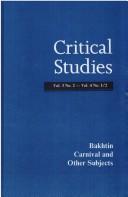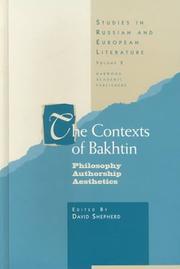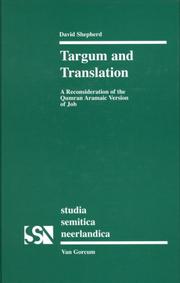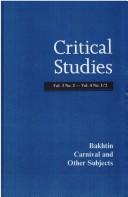| Listing 1 - 10 of 36 | << page >> |
Sort by
|

ISBN: 9051834500 9004455051 Year: 1993 Volume: 3, 2-4, 1/2 Publisher: Amsterdam Rodopi
Abstract | Keywords | Export | Availability | Bookmark
 Loading...
Loading...Choose an application
- Reference Manager
- EndNote
- RefWorks (Direct export to RefWorks)
Philosophy of language --- Philosophy and psychology of culture --- Bakhtin, Michael M. --- Bakhtin, M. M. --- Criticism and interpretation --- Congresses --- Critique et interprétation --- Congrès --- 82.09 --- Literaire kritiek --- 82.09 Literaire kritiek --- Critique et interprétation --- Congrès --- Congresses.
Book
ISBN: 9781859466056 9780429347535 0429347537 1859466052 9781000705010 1000705013 9781000703474 1000703479 9781000704242 1000704246 Year: 2015 Publisher: Newcastle upon Tyne : RIBA Publishing,
Abstract | Keywords | Export | Availability | Bookmark
 Loading...
Loading...Choose an application
- Reference Manager
- EndNote
- RefWorks (Direct export to RefWorks)
Modélisation des données du bâtiment --- Building --- Handbooks, manuals, etc --- Computer simulation --- Building information modeling --- Handbooks, manuals, etc. --- Builing management --- handbooks, manuals, etc --- Data processing --- Modélisation des données du bâtiment. --- Modélisation des données du bâtiment

ISBN: 9057025663 9057025671 Year: 1998 Volume: 2 Publisher: Amsterdam : Harwood academic publishers,
Abstract | Keywords | Export | Availability | Bookmark
 Loading...
Loading...Choose an application
- Reference Manager
- EndNote
- RefWorks (Direct export to RefWorks)
82.0 --- 82.0 Literatuurtheorie --- Literatuurtheorie --- Bakhtin, M. M. --- Criticism --- Literature --- Critique --- Littérature --- Congresses --- Aesthetics --- Congrès --- Esthétique --- Congresses.
Book
ISBN: 0415741696 9780415741699 9781315815169 9781317806714 9781317806721 Year: 2016 Publisher: New York : Routledge,
Abstract | Keywords | Export | Availability | Bookmark
 Loading...
Loading...Choose an application
- Reference Manager
- EndNote
- RefWorks (Direct export to RefWorks)
Book
ISBN: 9781107042605 1107042607 9781107337152 9781107617322 9781461950868 1461950864 1107337151 110750290X 1139893564 1107501296 1107506670 1107517060 110749737X 1107504007 1107617324 Year: 2013 Publisher: Cambridge Cambridge University Press
Abstract | Keywords | Export | Availability | Bookmark
 Loading...
Loading...Choose an application
- Reference Manager
- EndNote
- RefWorks (Direct export to RefWorks)
"Between the advent of motion pictures in the 1890s and the close of the 'silent' era at the end of the 1920s, many of the longest, most expensive and most watched films on both sides of the Atlantic drew upon biblical traditions. David J. Shepherd traces the evolution of the biblical film through the silent era, asking why the Bible attracted early film makers, how biblical films were indebted to other interpretive traditions, and how these films were received. Drawing upon rarely seen archival footage and early landmark films of directors such as Louis Feuillade, D.W. Griffith, Michael Curtis and Cecil B. DeMille, this history treats well-known biblical subjects including Joseph, Moses, David and Jesus, along with lesser-known biblical stars such as Jael, Judith and Jephthah's daughter. This book will be of great interest to students of Biblical studies, Jewish studies and film studies"--
Films bibliques --- Films muets --- Bible films --- Silent films --- Histoire et critique. --- Aspect religieux. --- History and criticism. --- Religious aspects. --- Bible --- In motion pictures. --- RELIGION / Biblical Studies / Old Testament. --- Moving pictures, Silent --- Silent motion pictures --- Motion pictures --- Biblical films --- Religious films --- Arts and Humanities --- Religion
Book
ISBN: 9781589832756 1589832752 Year: 2008 Volume: 54 Publisher: Atlanta Society of biblical literature
Abstract | Keywords | Export | Availability | Bookmark
 Loading...
Loading...Choose an application
- Reference Manager
- EndNote
- RefWorks (Direct export to RefWorks)
Bible films --- History and criticism. --- Jesus Christ --- In motion pictures. --- Bible --- 791.43:2 --- Biblical films --- Religious films --- 791.43:2 Film en religie. Film en godsdienst --- Film en religie. Film en godsdienst --- History and criticism --- Christ --- Cristo --- Jezus Chrystus --- Jesus Cristo --- Jesus, --- Christ, Jesus --- Yeh-su --- Masīḥ --- Khristos --- Gesù --- Christo --- Yeshua --- Chrystus --- Gesú Cristo --- Ježíš --- Isa, --- Nabi Isa --- Isa Al-Masih --- Al-Masih, Isa --- Masih, Isa Al --- -Jesus, --- Jesucristo --- Yesu --- Yeh-su Chi-tu --- Iēsous --- Iēsous Christos --- Iēsous, --- Kʻristos --- Hisus Kʻristos --- Christos --- Jesuo --- Yeshuʻa ben Yosef --- Yeshua ben Yoseph --- Iisus --- Iisus Khristos --- Jeschua ben Joseph --- Ieso Kriʻste --- Yesus --- Kristus --- ישו --- ישו הנוצרי --- ישו הנצרי --- ישוע --- ישוע בן יוסף --- المسيح --- مسيح --- يسوع المسيح --- 耶稣 --- 耶稣基督 --- 예수그리스도 --- Jíizis --- Yéshoua --- Iėsu̇s --- Khrist Iėsu̇s --- عيسىٰ --- Biblia --- Bible films - History and criticism. --- Jesus Christ - In motion pictures.

ISBN: 9023240170 Year: 2004 Publisher: Assen Van Gorcum
Abstract | Keywords | Export | Availability | Bookmark
 Loading...
Loading...Choose an application
- Reference Manager
- EndNote
- RefWorks (Direct export to RefWorks)
Bible. --- Dead Sea scrolls. --- Versions --- Qumran targum. --- Peshitta.
Book
ISBN: 9004358757 Year: 2004 Publisher: Assen : Royal Van Gorcum,
Abstract | Keywords | Export | Availability | Bookmark
 Loading...
Loading...Choose an application
- Reference Manager
- EndNote
- RefWorks (Direct export to RefWorks)
For nearly half a century, the Aramaic version of Job found amongst the scrolls at Qumran has been celebrated as the earliest example of that unique genre of Jewish bible translation known to the Rabbis as targum. In this groundbreaking study, the author challenges this assumption by re-evaluating this significant Qumran text in light of other ancient Aramaic versions of Job, including the Peshitta and Targum. After a fresh review of five decades of research on the Qumran text, the author draws on recent work in the study of the ancient Aramaic versions to chart a new course in its exploration. While both similarities and differences of approach among the respective Aramaic translators are illuminated by a series of examples drawn directly from the texts, the rigorous scrutiny of each version's re-presentation of its source text provides a firm basis for a reassessment of the relationship between the Qumran Aramaic version of Job and its Syriac and Targumic counterparts. By situating the Qumran version within the broader context of other ancient Aramaic versions, the author makes a significant contribution to our understanding of Aramaic idiom and style in the time of the Second Temple. More importantly, however, he offers a radical revision of the Aramaic version of Job's classification and a new and innovative perspective on its place in the panoply of ancient bible versions originating in this crucial period.
Bible. --- Dead Sea scrolls. --- Versions --- Qumran targum. --- Peshitta.
Book
ISBN: 1136651527 0203059697 1283843765 1136651454 9781136651458 Year: 1998 Volume: v. 2 Publisher: Amsterdam, Netherlands : Harwood Academic Publishers,
Abstract | Keywords | Export | Availability | Bookmark
 Loading...
Loading...Choose an application
- Reference Manager
- EndNote
- RefWorks (Direct export to RefWorks)
The fourteen essays collected in this volume, notwithstanding their diversity of subject matter and approach, share a concern with the contexts to which we need to refer in order to understand not only the origins, but also the potential of Mikhail Bakhtin's thought: contexts both immediate and oblique, personal and impersonal, intellectual and theoretical. Five of the essays are by well-known Russian scholars whose work on Bakhtin has not previously been translated in English; the other nine papers are by established and emerging Bakhtin specialists in North America, the United Kingdom, and E
Criticism --- Aesthetics --- Bakhtin, M. M.

ISBN: 9789004455054 9789051834505 Year: 1993 Publisher: Leiden; Boston : BRILL
Abstract | Keywords | Export | Availability | Bookmark
 Loading...
Loading...Choose an application
- Reference Manager
- EndNote
- RefWorks (Direct export to RefWorks)
| Listing 1 - 10 of 36 | << page >> |
Sort by
|

 Search
Search Feedback
Feedback About UniCat
About UniCat  Help
Help News
News